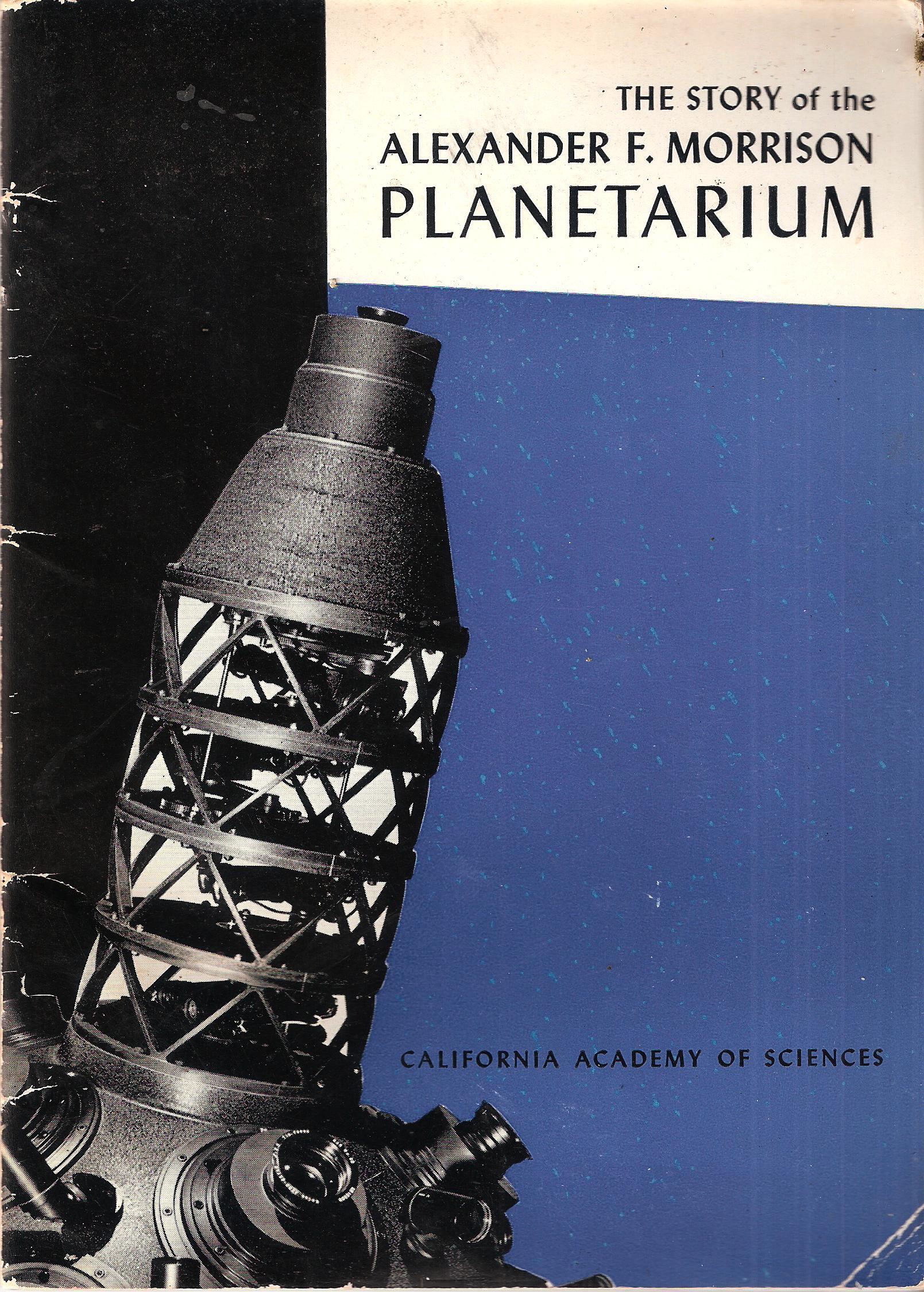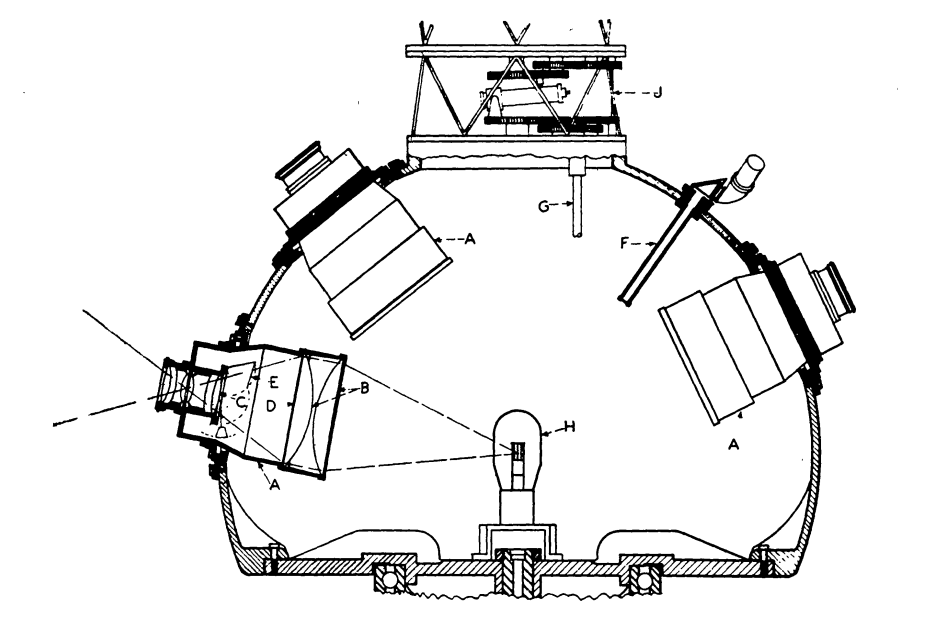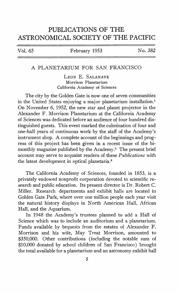Leon Edward Salanave: Gentleman, Scholar, Astronomer
We will let Leon speak for himself:
PUBLICATIONS OF THE
ASTRONOMICAL SOCIETY OF THE PACIFICVoL 65 - February 1953 - No. 382
A PLANETARIUM FOR SAN FRANCISCO
Leon E. Salanave
Morrison Planetarium
California Academy of SciencesThe city by the Golden Gate is now one of seven communities in the United States enjoying a major planetarium installation.[1] On November 6, 1952, the new star and planet projector in the Alexander F. Morrison Planetarium at the California Academy of Sciences was dedicated before an audience of four hundred distinguished guests. This event marked the culmination of four and one-half years of continuous work by the staff of the Academy's instrument shop. A complete account of the beginnings and progress of this project has been given in a recent issue of the bimonthly magazine published by the Academy.[2] The present brief account may serve to acquaint readers of these Publications with the latest development in optical planetaria.[3]
The California Academy of Sciences, founded in 1853, is a privately endowed nonprofit corporation devoted to scientific research and public education. Its present director is Dr. Robert C. Miller. Research departments and exhibit halls are located in Golden Gate Park, where over one million people each year visit the natural history displays in North American Hall, African Hall, and the Aquarium.
In 1948 the Academy's trustees planned to add a Hall of Science which was to include an auditorium and a planetarium. Funds available by bequests from the estates of Alexander F. Morrison and his wife, May Treat Morrison, amounted to $350,000. Other contributions (including the notable sum of $10,000 donated by school children of San Francisco) brought the total available for a planetarium and an astronomy exhibit hall to approximately half a million dollars. The completed Hall of Science was dedicated in February 1951 ; it houses not only the above-mentioned planetarium chamber, auditorium, and astronomy exhibit hall (with its Foucault pendulum), but also the Lovell White Hall of Man and Nature and the James Moffitt Library of Mammalogy and Ornithology - total cost, $1,100,000.

While plans for a building to house the planetarium were progressing, an unforeseen obstacle arose : where was the Academy going to get a star and planet projector ? Other major planetarium installations have been equipped with the well-known Zeiss projector. After World War II the Zeiss factories at Jena passed into Russian hands; inquiry made in 1948 at the New York office of the Zeiss company brought the reply that a planetarium projector could not be supplied at that time or in the foreseeable future.
During World War II the California Academy of Sciences had built up a well-equipped shop to repair vital optical instruments for the United States Navy. Under the supervision of Dr. G. Dallas Hanna, curator of paleontology, whose work in microscopy had led him to become an expert in fine instrument making, approximately 10,000 optical parts were manufactured. from the ranks of local amateur astronomers and telescope makers. Faced with the obstacle of an unavailable projector, the Academy's director approached Dr. Hanna with this formidable instrument-making task. Together, these two men decided that the task was not beyond the capabilities of their shop staff. In March 1948 they called in Dr. Russell W. Porter from Pasadena to act as a special consultant, in order to reassure the Board of Trustees about such a large undertaking. Dr. Porter was so convincing that by July 1 of that year the Academy embarked on its ambitious venture: "To build a star and planet projector equal to or better than the Zeiss instrument."
Work on the new projector proceeded along experimental lines. Although patents on the Zeiss instrument had expired, no detailed drawings of the design were available. Staff members of the Academy shop knew only in a general way the principles and some of the details of a star and planet projector. Had working drawings been available, it is probable that the finished Academy instrument would have followed the Zeiss plan closely. As it turned out, there are conspicuous differences, along with the inevitable similarities.
Plate I shows the finished projector (complete except for the lunar mechanism in the upper planet cage). Thirty projector units for star fields are arranged about the two hemispheres ; the planet cages are mounted on the poles, and their common axis is perpendicular to the ecliptic. Two separate projection units, mounted on the ends of the planet cages, fill in the blind spots on the star hemispheres and complete the array of thirty-two star fields. The geometrical arrangement of the mosaic of projected stars follows the pattern used by the Zeiss designers, that is, the thirty-two facets of a truncated icosahedron are used to represent the complete celestial sphere.

Fig. 1. Cross-section diagram of star-hemisphere, north (Morrison Planetarium Projector).
A. Three of thirty star field projector units, equipped with F/2.5 Eastman Aero-Ektars.
B. Condenser lenses, 7 1/2 inches diameter.
C. Ball-bearing mount for gravity-operated shutter.
D. Aluminum film evaporated on glass, with holes to project star images.
E. Behind-the-lens shutter to cut off stars at horizon.
F. One of twenty special projectors for first magnitude stars.
G. Line-shaft carrying "annual motion" to planetary projectors; ten revolutions of this shaft equal one "planetarium year."
H. 750-watt projection lamp.
J. One of three units in the northern planet cage; this is the Mars projector. The sun and moon are stacked above the unit shown.
Projection lenses on the hemispheres are Eastman AeroEktars, of 7 inches focus and F/2.5; the two accessory star projectors are equipped with Ross lenses of 5 inches focus and F/4.0. These optical parts were salvaged from U.S. Air Force cameras, the lenses having been completely cleaned, coated, and remounted in the Academy's optical shop. Note that the very massive star hemispheres are placed nearer the center of mass than the lighter planet cages - a reversal of the Zeiss design. Driving motors and other control equipment are housed inside the central body, thus giving the whole a neat, uncluttered appearance. Motors for daily and annual motion are of the reversible D.C. type, powered by Amplidyne units that permit smooth, continuously variable rates. A "day" ranges from one minute and fifteen seconds to twenty minutes in length ; a "year" can be anything from twenty-four seconds to nearly seven minutes. Precessional motion, which is accomplished by rotating the star and planet assembly around its longitudinal axis, has a fixed period of three and one-half minutes. These respective motions of the instrument parts are scarcely audible, contributing much to the illusion of reality.
The Academy's projector claims at least two distinct improvements over its predecessor: (a) star images are more realistic, i.e., pointlike, and (b) demonstrations with lecture can be given automatically, at the flick of a single switch. The first feature is possible because of the increased focal length and greater aperture of star projector lenses. Also, instead of circular holes in metal foil, we use irregular apertures in a coating of aluminum on glass to produce star images of various magnitudes. These were achieved by placing selected carborundum grains at computed places on plates and evaporating an opaque coating of metal over the glass (see Fig. 1, D). Thirty-eight hundred stars (magnitude 5.79 or less) and twenty-seven naked-eye nebulae and star clusters are projected from the thirty-two plates. Necessary computations, made by the writer, were done with the IBM installation at the University of California Computer Laboratory, Berkeley. (The Milky Way is reproduced by two special projectors, identically as in the Zeiss instrument.) The stars are fewer in number than those provided by the Zeiss projector, but up to the date of this writing no one has called our attention to a noticeable omission !
The second novel feature is made possible by an elaborate system of switches and relays that can be operated in any consecutive order of two hundred fifty steps by means of metallic strips on the back of magnetic recording tape that carries the lecture. As each bit of metal tape passes over a magnetic pickup, a stepping relay is impulsed and a predetermined circuit is closed (or opened) through a plugboard. At the same time the lecturer is heard in the auditorium via any one or all of thirteen speakers behind the perforated dome, the motion or motions of the projector corresponding to what is being said. This feature is not used for the regular adult shows but is intended for use during the routine (and very numerous) demonstrations to elementary school classes.

The operations staff of the Morrison Planetarium is at present as follows : George W. Bunton, manager and lecturer ; Leon E. Salanave, lecturer; Alvin C. Gundred, technician.
Those who worked under the supervision of Dr. G. Dallas Hanna on the $140,000 projector are: A. S. Getten, design of the instrument; Alvin C. Gundred and George W. Bunton, design and installation of electrical circuits and special projectors ; Leon E. Salanave, astronomical data and computations ; Frances Greeby, optical work and the making of star projection plates; Raymond Greeby and Fredrick Lehmann, instrument making; Daniel Parsons and Robert Dempster, lens making ; L. A. Parsons, structural engineering; Herbert Jow, drafting.
The California Academy planetarium projector has been judged a success by all who have seen it in operation. Most of the special projectors commonly found in a modern installation have yet to be made ; we are not soon going to run out of work ! It may be of interest to others that we have a complete set of working drawings and patterns, from which any part or the whole of the projector could be made.
[1] Others, with year of dedication, are : Chicago, 1930 ; Philadelphia, 1933; Los Angeles, 1935; New York City, 1935; Pittsburgh, 1939; Chapel Hill (North Carolina), 1949.
[2] Pacific Discovery, 5, 6, 1952.
[3] See also Sky and Telescope, 12, 2, 1952.
Source: https://web.archive.org/web/20181030042420/http://iopscience.iop.org/article/10.1086/126518/pdf
Also: https://iopscience.iop.org/article/10.1086/126518/pdf
... And so we see that Leon Salanave was a Class 1 nerd and also a Class 1 maker, before such words even existed.
Leon was actually one of the youngest people on the project - many of the others were experienced machinists nearing the ends of their careers - the sort of people that Human Resources departments now refuse to hire.
Note the suggestion that the project might be open-sourced: "It may be of interest to others that we have a complete set of working drawings and patterns, from which any part or the whole of the projector could be made."
Open source hardware! In 1953! Imagine that!
Food for thought.
